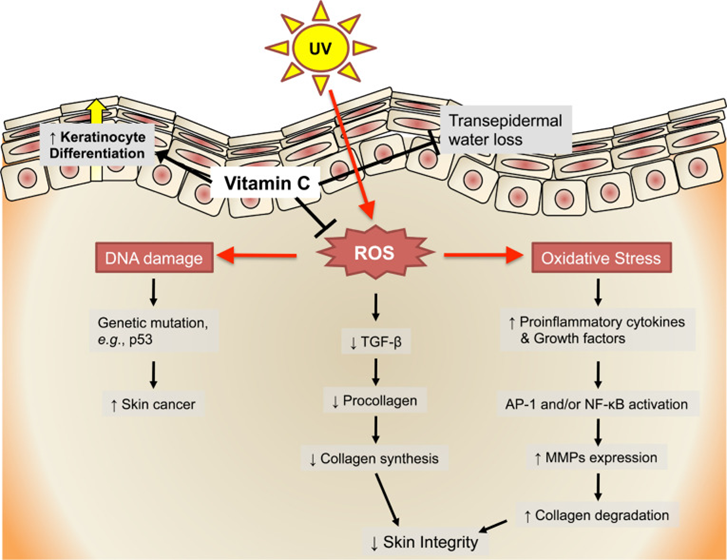The skin is a vital organ as crucial to health as the liver, lungs, and kidneys. It is the largest organ in the body and the first line of defense against damage from toxins and pathogens. It is an integral part of the innate immune system and contains melanocytes, which produce melanin, a compound that absorbs UV light and reduces skin cancer risk (Bai 2020).
Like every cell and organ in the body, the skin depends on nutrients and hydration for optimal function. Compromised nutrition status leads to compromised skin integrity and function (Park 2015):
|
Micronutrients |
Roles |
Skin disorders |
|
Modulates proliferation of epidermal keratinocytes and dermal fibroblasts Prevents UV irradiation-mediated skin damage Useful for the prevention and treatment of psoriasis, ichthyosis, skin cancer, and acne |
Atopic dermatitis Delayed wound healing |
|
|
Suppresses UV irradiation-triggered production of free radicals, protecting cells from oxidative stress Attenuates UV irradiation-mediated damages in the skin Promotes cutaneous wound healing Increases epidermal moisture content, improving skin hydration |
Thickening of the stratum corneum Subcutaneous bleeding Delayed wound healing in scurvy |
|
|
Improve innate immunity (through stimulation of cathelicidin antimicrobial peptide production) Modulates inflammation, angiogenesis, wound healing |
Atopic dermatitis |
|
|
Suppresses lipid peroxidation Modulates photoaging Photocarcinogenesis Exhibits anti-inflammatory roles |
Skin ulcerations Changes in skin collagen cross-linking |
|
|
Protects from photodamage Exhibits antimicrobial activity |
Epidermolysis bullosa Atopic dermatitis |
|
|
Serves as an antioxidant Stimulates the maturation of collagen Modulates melanin synthesis |
Steely-hair syndrome |
|
|
Protect skin from UV irradiation-induced oxidative stress Useful for the prevention and treatment of psoriasis |
Psoriasis Epidermolysis bullosa Certain skin cancer |
|
|
|
|
|

AP-1, activation protein-1; MMPs, matrix metalloproteinases.
Source: Park, Kyungho. “Role of micronutrients in skin health and function.” Biomolecules & therapeutics vol. 23,3 (2015): 207-17. doi:10.4062/biomolther.2015.003 This is an Open Access article distributed under the terms of the Creative Commons Attribution Non-Commercial License (http://creativecommons.org/licenses/by-nc/3.0/)
Bai, Halbert, and Connor Graham. “Introduction: Skin.” The Yale Journal of Biology and Medicine vol. 93,1 1–2. 27 Mar. 2020. This is an open access article distributed under the terms of the Creative Commons CC BY-NC license, https://www.ncbi.nlm.nih.gov/pmc/articles/PMC7087064/
Park, Kyungho. “Role of micronutrients in skin health and function.” Biomolecules & therapeutics vol. 23,3 (2015): 207-17. doi:10.4062/biomolther.2015.003 This is an Open Access article distributed under the terms of the Creative Commons Attribution Non-Commercial License (http://creativecommons.org/licenses/by-nc/3.0/)